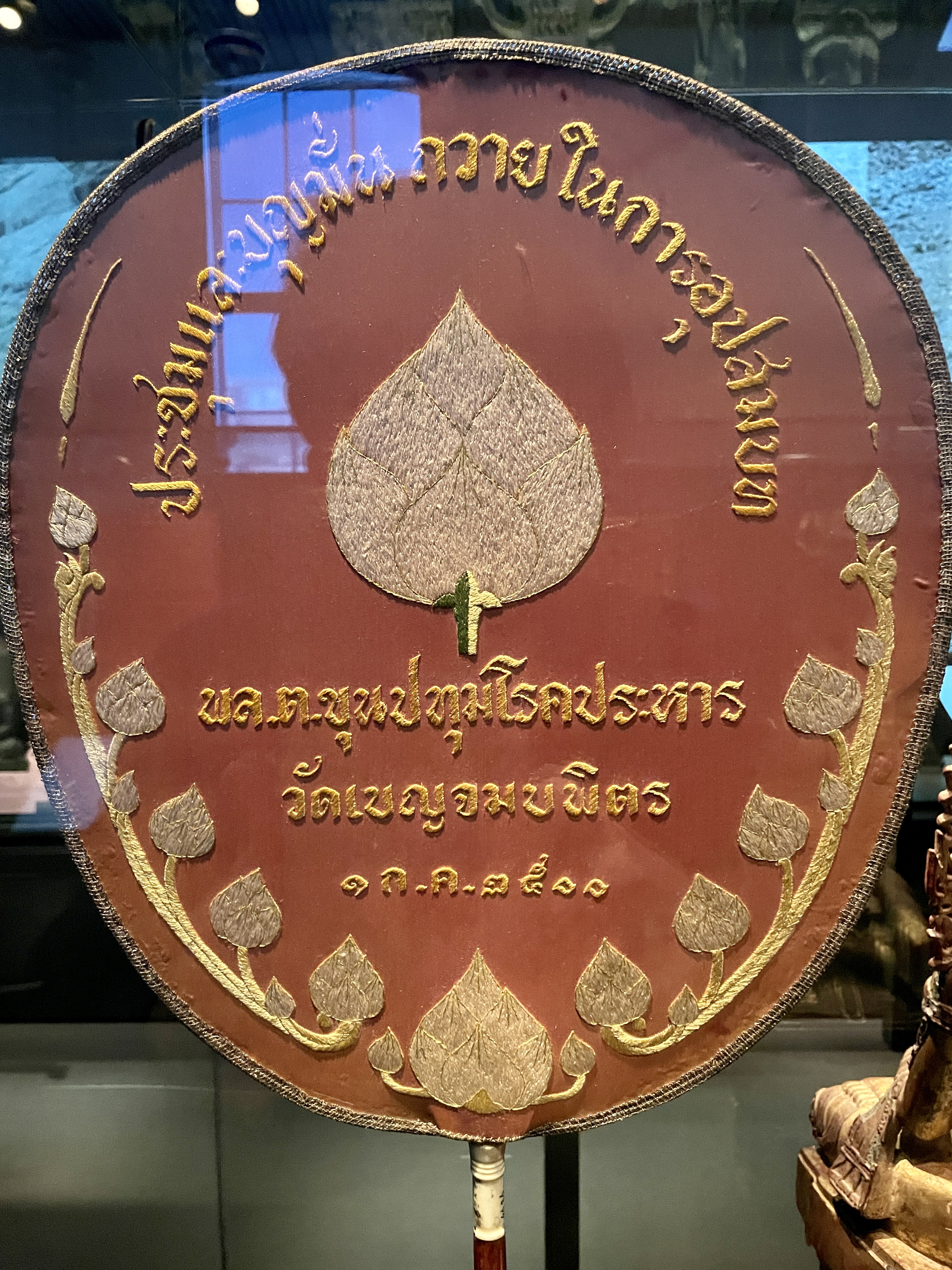Accession card
Description
As we walked through the hall of "Asia" to reach "Africa," the Volkenkunde Museum's only displayed object from Thailand caught my eye, its embroidered metal threads glinting in the dark. Embroidered script and teardop-shaped lotus buds adorn a piece of silk stretched tight around a frame to form an oblong fan that would have been held by a monk near his face as he chanted during rituals at a temple, in a homes, or in other spaces where monks are invited to preside. The fan is intented to obscure the face of the monk to shift a layperson's focus away from their individual human self, and to redirect it towards the sacred words the monk is speaking and his saffron robes that represent all monks and the Buddha. It also provides necessary breeze on heavy humid days -- did the sacred function or the cooling fuction come first? Most likely unintentionally, the fan's digital label also eschews an individualist approach, employing iconographic analysis to explain the presence of the lotus flower and the ficus leaf, and then describing how today, monks are permitted to possess certain objects in addition to the eight personal items specified in the Pali canon. How the fan fits into this narrative is unclear; fans are not among these eight items that are not actually enumerated in the label, nor can they be found in the label's list of things that contemporary monks are allowed use, such as medicines, books, and clocks. The exact date of the fan's production or use is unknown; a range is proposed instead, from 1900-1971.
Yet. The Thai script that was painstakingly embroidered onto the fan tells us the precise date upon which the fan made its debut, and offers insight into the purpose of its creation and subsequent function. The fact that the fan includes these details suggests that it was part of a ritual for, or related to, a person with certain social and material capital, someone who could commission the embellishment of an otherwise standarized fan to commemorate a specific event. The fan was first used on July 1, 1957, or ๑ ก.ค. ๒๕๐๐ . The occasion is also identified - "A gathering and merit-making ceremony, offered as part of an ordination." Underneath a large lotus bud, more information can be found: "Lieutenant General Pathum Rokprahan, Benjamabopit Temple [Bangkok], July 1, 1957." If Volkenkunde had consulted one of Leiden's many Thai speakers when cataloguing this object, they could have acquired these details in minutes. They could have conducted further research into the life and accomplishments of Pathum Rokprahan, a doctor who was born in 1903 and educated at Siriraj Hosptial in Bangkok. In 1940, he studied radiology at Northwestern University in Chicago, Illinois. Dr. Pathum went on to pioneer the development of prosthetic limbs for Thai soldiers wounded in the Korean War, and also advanced the treatment of polio in Thailand, especially in relation to reabilitation activities for youth with polio. Why he ordained as a monk in 1957 at Benjamabopit Temple is unclear at this point; all of this information has been gleaned from a quick google search in Thai.
In the exhibitionary scheme of the Volkenkunde, the textilic fan is "read" and decoded for visitors to illustrate vagely articulated Buddhist principles regarding enlightenment and the asceticism of the monkhood. In its attempts to generalize, the label forecloses an opportunity for specificity and productive questioning. How do objects like fans come to have meaning in Theravada Buddhist cosmology? Why might individuals like Dr. Pathum make personalized fans for monks? How did Dr. Pathum's fan end up in Leiden? How do Western and Buddhist approaches to healing, health, and medicine overlap and diverge? Does a fan remove individuality only at its expense? How can museums rethink their practices and frames, and center the experiences and knowledges of diverse communities in the elaboration of objects?
Code
Date
Location
Title
Medium
- Image



